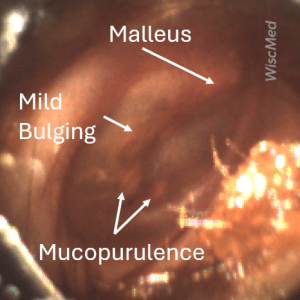
Mucopurulence – February 8, 2024
A 2-year-old child presents to the emergency department (ED) for evaluation of congestion, cough, and low-grade fever over the past 24 hours. The parents are concerned she may have an ear infection since she was recently treated for otitis media with “a pink medicine.” The child finished the full course of antibiotics last week. In the ED, the child is afebrile with normal vital signs and an overall reassuring respiratory examination. Her Wispr digital otoscope exam is shown.
Which of the following is true:
- The child has unresolved acute otitis media and should be started on a different antibiotic.
- The child’s tympanic membrane demonstrates evidence of resolving acute otitis media.
- The child’s tympanic membrane demonstrates severe bulging.
- The child has developed bullous myringitis secondary to acute otitis media.
Answer B. The child’s tympanic membrane demonstrates evidence of resolving acute otitis media.

The child in this case has resolving acute otitis media (AOM) as evidenced by only mild bulging and the presence of mucopurulent spots on the anterior inferior quadrant of the tympanic membrane (TM). Mucopurulent spots are from a collection of inflammatory cells adhering to the middle ear surface of the TM. The presence of these spots suggests that the acute phase of the middle ear infection is receding. Here is a 25-day image-series demonstrating the resolution of AOM including the development of the hallmark mucopurulent spots.
The ear drum (tympanic membrane) in this case does not demonstrate severe bulging as the malleus is still discernable.
Bullous myringitis is often thought of as a severe case of acute otitis media. The hallmark of bullous myringitis is severe bulging with blistering on the tympanic membrane. There is no severe bulging or blistering in this case.
Recall that in order to confidently diagnose AOM, the TM should demonstrate moderate to severe bulging. In cases where the TM has only mild bulging (typically occurs in the superior portion of the pars flaccida), the diagnosis of AOM requires either intense erythema or pain—neither of which are present in this child. Mucopurulent material deposited on the inner surface of the TM may occur as the purulent middle ear fluid is cleared during resolution of AOM. This suggests the patient’s TM, while certainly not normal, is not acutely infected and not in need of another course of antibiotics.
WiscMed has created a visual diagnosis guide to common ear conditions which may be found here.
Here is the complete video exam.








































































































































































































